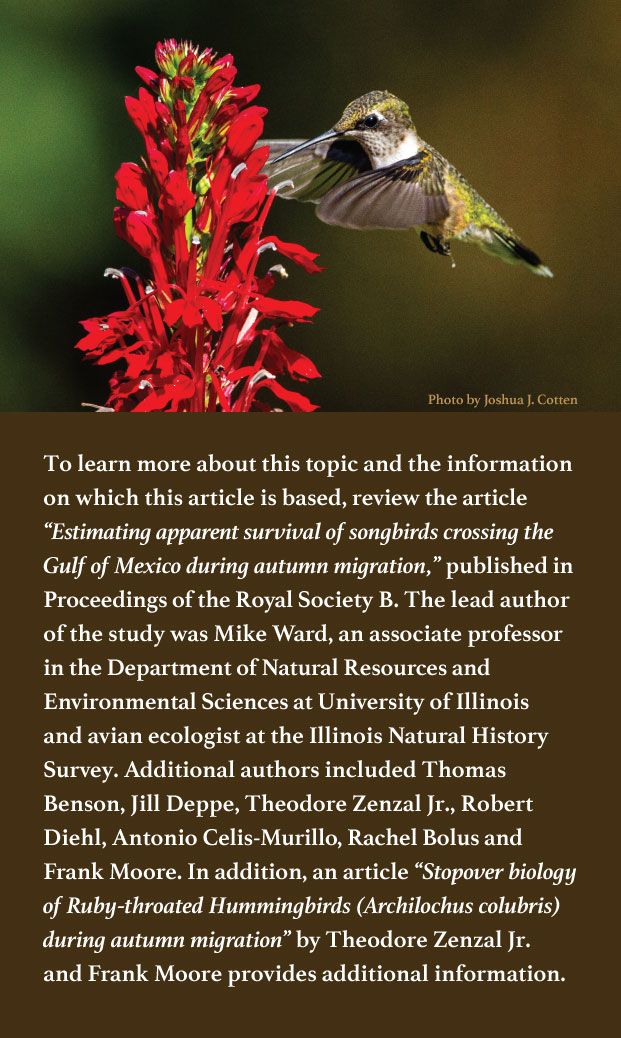
Photo by Michael R. Jeffords.



Photo by Michael R. Jeffords.

The bundle of energy we call a ruby-throated hummingbird has an extremely high metabolic rate. It must eat constantly to stay alive. At rest, a ruby-throat’s heart beats about 250 times a minute. During aerial acrobatics, the rate soars above 1,200 beats a minute. Given a diet of nectar, small insects and spiders, staying in temperate weather conditions is a must. Eating and maintaining body temperature means survival. Hummingbirds caught by an unanticipated cold snap during migration, or even a hard frost in fall, often die.
A successful migration south not only requires leaving early enough—usually starting in late August or September in Illinois—but also an ample supply of calories along the entire migratory route to replenish burned-up calories on a daily basis. Fall migratory destinations for ruby-throats include areas as far north as extreme southern Texas, down through Mexico, and as far south as Costa Rica. Some migrants are even seen in Panama.
While it is theoretically possible for some ruby-throats to store up enough fat to power a trans-Gulf of Mexico water crossing, all factors such as weather conditions must be tilted in their favor. Thus, ruby-throats typically stay over land to supply calories during the entire migration. Crossing the 1,000 kilometer (621 miles) Gulf of Mexico is just too risky. While ruby-throats can theoretically store up enough energy, it is more risky than it is for other neotropical migrants such as warblers and thrushes that can make the trans-Gulf flight in approximately 22 hours.

The potential of land development and destruction of native habitats along the Gulf Coast and in Central America impacting migrating bird species has been raised. Neotropical migrants, including warblers and thrushes, make stops to “tank-up” on native berries and such before embarking on the long non-stop flight over Gulf waters. Their last stops were traditionally made on land within a few miles of Gulf waters to eat native foods and replenish their fat storage. Many of these lands close to the Gulf are high economic value areas and are being developed. Commercial interests rule and natural areas are destroyed, robbing neotropical migrants of their essential “fuel stops” they depend on. Granted, these birds could stop even further inland to eat, but that makes the trek even longer. Will a similar scenario come into play for the fall migrating ruby-throated hummingbird that needs a continuous food supply over the land it navigates during migration? Will current and future land development and destruction of native food-bearing habitats impact the ruby-throats? Time will tell.
It is tempting to take in hummingbird feeders soon after you know that the birds you have fed all summer have taken off southward. Migration usually starts abruptly. One day the ruby-throats are at feeders. The next day, they are gone. Don’t take in feeders immediately. There is always a chance that migrating ruby-throats from the north, northeast or east will be passing through. Your supply of food energy may be just what they need!
Robert J. Reber is an emeritus faculty member in the Department of Food Science and Human Nutrition of the University of Illinois at Urbana–Champaign. He has been a lifelong student of many aspects of the Natural World, including archaeology. Bob has served as a managing editor and author for publications such as The Illinois Steward magazine and the Illinois Master Naturalist Curriculum Guide.
Submit a question for the author
Question: Female color?